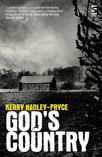The Guattari Effect
- Kerry Hadley
- Oct 3, 2019
- 3 min read

I took this photo with my phone this morning. It was about 6.45am. It's not a manipulated image. That's how it looked. I'd been out since about 5.30am, taking the dogs for their usual walk. We start off in the pitch black darkness, and we all (including both dogs) have to wear torches, and even then, often, I can only really see them in my peripheral vision. Even by the time the sun starts to rise, I always think the place - that place there, next to the canal - looks like it's part of a dreamscape.
Yesterday, I read a chapter from a book recommended to me by Tina Richardson. She said it would be hard going, and it was. But this struck a chord:
Guattari says: 'The era of the digital keyboard will soon be over; it is through speech that dialogue with machines will be initiated - not just with technical machines, but with machines of thought, sensation and consultation.' (p 97)
So today, I read the other chapter she recommended, which she said might be a bit less difficult. Here's a quote that struck me, especially in light of that image there:
'These places - rocks, springs, creeks, trees - which seem natural to us, are cultural places, in the sense that events are attached to them: mythological episodes, oneiric interpretations and re-enacted historical and everyday experience of the people who journey in these places, by physically camping in them or by visiting them mentally in dance performances or dreams.'
And:
'Even what happens in dreams is responsible for the balance between the forces of nature and the health of people and all other living beings.' (p106)
That's Barbara Glowczewski in the midst of talking about Aboriginal culture. It's apt. And it made me think about something else I know about Aboriginal culture: when I was writing my dissertation for my first degree (in the Black Country dialect) I researched Diana Eades, who found that whilst Aboriginal societies place high priority on maintaining and developing social relations, and much of their lives is shared in some way with a number of relatives, indeed, much of the business of day-to-day living occurs in open outside areas such as parks and other public places, or on the main streets of towns, they do, however, value highly personal privacy which cannot be ensured in terms of physical privacy. Eades found that it is through their indirect style of verbal interaction that Aboriginal people experience much personal privacy which is lacking in 'reality'. For example, one way in which Aboriginal people respond to the much more direct communication style of white speakers is through the use of 'gratuitous concurrence' (Liberman 1985). This is where Aboriginal speakers say 'yes' not necessarily in agreement but to 'facilitate the on-going interaction, or to hasten its conclusion.' (Eades in Maybin & Mercer (1996). It is interesting, this Aboriginal technique of using language as a physical boundary, or as an actual part of the desire for space or place, and the link between their use of linguistic privacy, and place is something I was reminded of, and which, I think, is something used by those in the Black Country.
Keeping in mind I am NOT engaging in a linguistic study, and (as discussed with Paul Evans, Nick Royle and Tina Richardson only last week) I am not keen to include actual dialect in my novel, I can see how this employment of a kind of 'yes of gratuitous concurrence', and also silence (another technique used by Aboriginal people) as a link between personal space/place and language, is something I need to exemplify more in the novel because this is, actually, a Black Country linguistic technique. The complexity will be in the translating of this - or the communicating of it - into written form, describing (or 'showing') somehow, the inner workings of Antony's mind, or his father's during their silences might be like watching some kind of film noir, with quiet close-ups and with only diegetic sound.
Eades, D. M. (1983). 'English as an Aboriginal Language in South-East Queensland', PhD thesis, University of Queensland. In J. Maybin and N. Mercer, eds. Using English from Conversation to Canon (1996), New York: Routledge.
Guattari, F. (1995). Chaosmosis: an ethico-aesthetic paradigm. Translated by Paul Bains and Julian Pefanis, Bloomington and Indianapolis: Indiana University Press.
Glowczewski, B. (2011). Guattari and Anthropology: Existential Territories among Indigenous Australians. In A. Alliez and A. Goffey, eds. The Guattari Effect, London, New York: Continuum International Publishing Group. pp. 99-114
Liberman, K. (1985). Understanding Interaction in Central Australia: an ethnomethodological study of Australian Aboriginal People, Boston, Mass., Routledge and Kegan Paul.









Comments